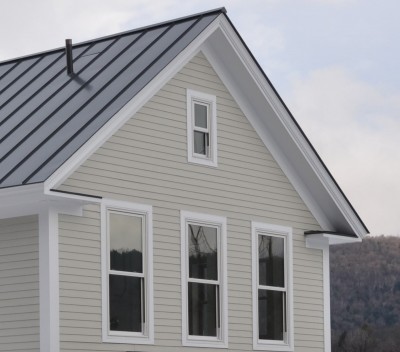I have been thinking a lot about traditional vs. modern home design. These terms are gross oversimplifications and this is the categorization of style issues I like to complain about. In the eyes of the populace it seems that modern still connotes white boxy houses with flat leaky roofs. Traditional has become a bastardized cheapened re-interpretation of the older houses found in the neighborhood. Architects working in the modern style used to be “out of touch”, overly intellectual”, “never swung a hammer”. Few are that anymore. Builders used to be scholars of the vernacular and learned the rules of convention and proportion in addition to construction . That mostly went out the window decades ago. Speaking abstractly, when I look at a pleasing-to-the-eye older house in Brattleboro, say a two family Greek Revival, I see an interplay of proportion, traditional details and an overall set of rules. A successful modern building would not try to copy this but instead perhaps be more true to available building materials and methods and not try to engage in historical fakery.
A successful modern building would still need to play by a set of rules even if those rules have been updated considerably in the last 100 years. Although some of the more mathematical rules such as the golden section seem to stand outside the progression of time and are perhaps more to be thought of as universal truths.
Think Music
In music there are definite rules that nearly all styles play by; scales, rhythms and harmonics to name a few. In the past, music styles have been greatly segregated. In modern times the separating walls have eroded. Musicians now draw on a wide variety of influences and new music is increasingly hard to categorize according to style. The internet has accelerated this phenomenon greatly and the music world is experiencing an artistic renaissance. The world of residential architectural design is as well although at a slower pace. The average 35 year old new home buyer has probably been exposed to modern design much more than a generation ago. The house that their parents wanted in House and Garden magazine is not necessarily what the younger generation, who are more likely to peruse design focused websites on the internet or subscribe to Dwell, want anymore simply because they have seen the alternatives. Although developers and the banks seem a bit slow to recognize this there are exceptions.
Like any good musician, an architect must continually practice the fundamentals. In my case that means studying and working within the successful local vernacular and try to do it in a scholarly way without being too anachronistic. And occasionally I am given license to fly!





